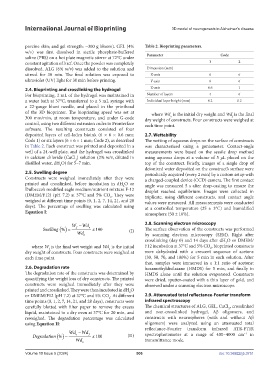Page 514 - IJB-10-5
P. 514
International Journal of Bioprinting 3D model of neurogenesis in Alzheimer’s disease
porcine skin; and gel strength: ~300 g bloom). GEL (4% Table 2. Bioprinting parameters.
w/v) was first dissolved in sterile phosphate-buffered Parameter Code
saline (PBS) on a hot plate magnetic stirrer at 72°C under
constant agitation of 3 rcf. Once the powder was completely 1 2
dissolved, ALG (6% w/v) was added to the solution and Dimension (mm)
stirred for 30 min. The final solution was exposed to X-axis 6 6
ultraviolet (UV) light for 30 min before printing. Y-axis 6 6
2.4. Bioprinting and crosslinking the hydrogel Z-axis 0.6 1
For bioprinting, 2 mL of the hydrogel was maintained in Number of layers 4 6
a water bath at 37°C, transferred to a 5 mL syringe with Individual layer height (mm) 0.2 0.2
a 22-gauge blunt needle, and placed in the printhead
of the 3D bioprinter. The bioprinting speed was set at where Wd is the initial dry weight and Wd is the final
f
o
300 mm/min, at room temperature, and under G-code dry weight of constructs. Four constructs were weighed at
control, using two different extrusion codes in Pronterface each time point.
software. The resulting constructs consisted of four
deposited layers of cell-laden bioink (6 × 6 × 0.6 mm; 2.7. Wettability
Code 1) or six layers (6 × 6 × 1 mm; Code 2), as described The wetting of aqueous drops on the surface of constructs
in Table 2. Each construct was printed and deposited in a was characterized using a goniometer. Contact-angle
well of a 24-well plate, and the hydrogel was crosslinked measurements were based on the sessile drop method
in calcium chloride (CaCl ) solution (2% w/v, diluted in using aqueous drops at a volume of 5 μL placed on the
2
distilled water, dH O) for 5–7 min. top of the construct. Briefly, images of a single drop of
2
deionized water deposited on the construct’s surface were
2.5. Swelling degree periodically acquired (every 2 min) by a custom setup with
Constructs were weighed immediately after they were a charged-coupled device (CCD) camera. The first contact
printed and crosslinked, before incubation in dH O or angle was measured 5 s after drop-casting to ensure the
2
Dulbecco’s modified eagle medium/nutrient mixture F-12 droplet reached equilibrium. Images were collected in
(DMEM/F12) (pH 7.2) at 37°C and 5% CO . They were triplicate, using different constructs, and contact angle
2
weighed at different time points (0, 1, 2, 7, 14, 21, and 28 values were measured. All measurements were conducted
days). The percentage of swelling was calculated using at a controlled temperature (25 ± 3°C) and humidified
Equation I: atmosphere (50 ± 10%).
W − Wd o 2.8. Scanning electron microscopy
f
Swelling % () = Wd o x 100 (I) The surface observation of the constructs was performed
by scanning electron microscopy (SEM). Right after
crosslinking (day 0) and 14 days after dH O or DMEM/
2
where W is the final wet weight and Wd is the initial F12 incubation at 37°C and 5% CO , bioprinted constructs
2
f
o
dry weight of constructs. Four constructs were weighed at were dehydrated with a crescent sequence of acetone
each time point. (30, 50, 70, and 100%) for 5 min in each solution. After
that, samples were immersed in a 1:1 ratio of acetone:
2.6. Degradation rate hexamethyldisilazane (HMDS) for 5 min, and finally in
The degradation rate of the constructs was determined by HMDS alone until the solution evaporated. Constructs
quantifying the weight loss of dry constructs. The printed were dried, sputter-coated with a thin layer of gold, and
constructs were weighed immediately after they were observed under a scanning electron microscope.
printed and crosslinked. They were then incubated in dH O
2
or DMEM/F12 (pH 7.2) at 37°C and 5% CO . At different 2.9. Attenuated total reflectance-Fourier transform
2
time points (0, 1, 2, 7, 14, 21, and 28 days), constructs were infrared spectroscopy
carefully blotted with filter paper to remove the excess The chemical structures of ALG, GEL, CaCl , crosslinked
2
liquid, maintained in a dry oven at 37°C for 20 min, and and non-crosslinked hydrogel, Aβ oligomers, and
reweighed. The degradation percentage was calculated constructs with neurospheres (with and without Aβ
using Equation II: oligomers) were analyzed using an attenuated total
reflectance-Fourier transform infrared ATR-FTIR
Wd − Wd −1
Degradation % () = o f x 100 (II) spectrophotometer at a range of 400–4000 cm in
Wd o transmittance mode.
Volume 10 Issue 5 (2024) 506 doi: 10.36922/ijb.3751

